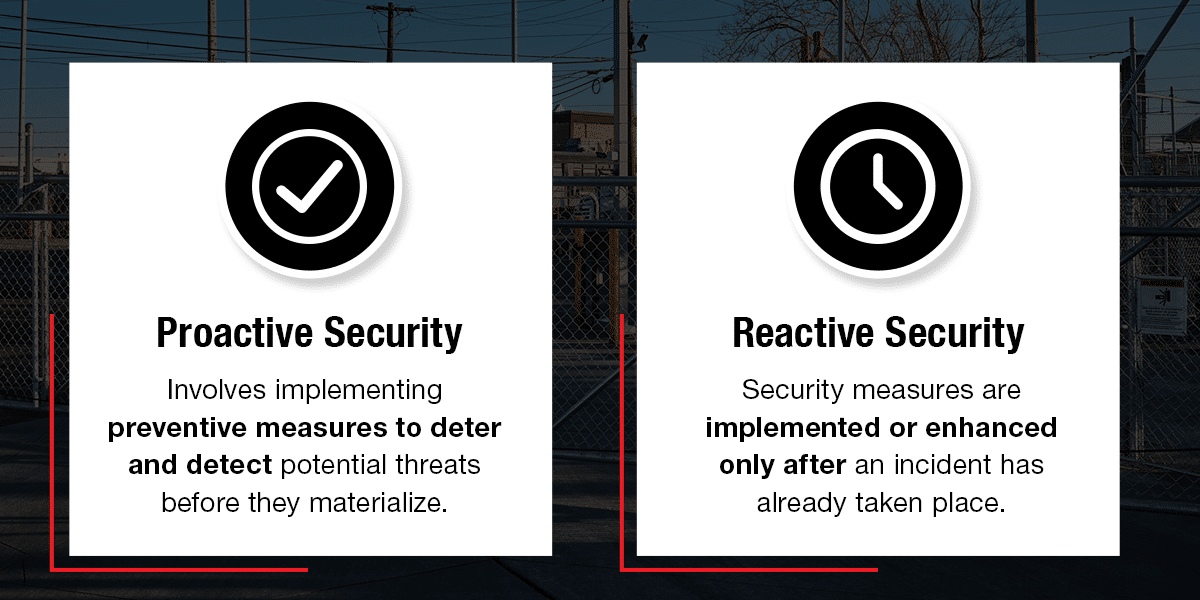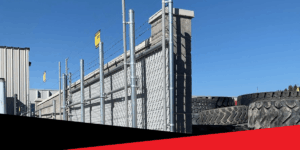Businesses face a multitude of security threats. From theft and vandalism to unauthorized access, the risks are real. A comprehensive security strategy is essential to safeguard your property, people, and assets. At the core of this strategy lies a critical decision — will you take a proactive or reactive approach to perimeter security?
This article explores proactive vs. reactive perimeter security, underscoring the importance of proactive measures and outlining actionable steps to strengthen your property’s first line of defense.
Proactive Security
Proactive perimeter security involves implementing preventive measures to deter and detect potential threats before they materialize. Rather than waiting for an incident, proactive security takes a forward-thinking approach to identify vulnerabilities and mitigate risks preemptively.
At its core, proactive perimeter security is about establishing a robust, multi-layered defense that discourages would-be intruders from attempting a breach. This forward-thinking strategy employs a combination of the following to create a formidable obstacle for criminals:
- Physical barriers
- Advanced technology
- Vigilant monitoring
Reactive Security
Reactive perimeter security operates on a wait-and-see basis. With a reactive approach, security measures are implemented or enhanced only after an incident has already taken place. This post-incident response often includes investigating the breach, assessing the damage, and taking corrective action to prevent future occurrences.
Reactive security can help identify gaps and guide improvements, but it does little to stop crimes in progress or minimize the impact of a successful intrusion. Essentially, reactive perimeter security leaves your property vulnerable until an incident exposes weaknesses in your defenses.
Why Proactive Perimeter Security Is So Important
In 2023, there were over 42,000 burglaries on commercial properties in the U.S. With proactive perimeter security measures, business owners can reduce the chances of burglaries on their property. The advantages of taking a preventive approach include the following:
Preventing Financial Losses
Proactive security prevents costly financial losses. Theft, vandalism, and other criminal activities can result in substantial monetary consequences, including:
- Stolen assets
- Property damage
- Operational disruptions
By deterring these incidents before they occur, proactive measures help safeguard your bottom line and protect your investments.
Mitigating Ripple Effects
The impact of a security breach extends beyond direct financial losses to reputation damage or high turnover as a consequence of employees feeling unsafe. As a senior security manager at a national transportation provider pointed out, “Theft or repeated theft can create ripple effects, like employees feeling unsafe and overworked or customers reacting to a negative brand reputation, that generate a cost that is not always associated with the bottom line but is still detrimental to the company’s mission.”
Proactive security helps mitigate these ripple effects, maintaining a positive work environment and preserving your brand’s reputation.
Deterring Criminals
Visible, proactive security measures are a powerful deterrent to potential intruders. When criminals see that a property is well-defended with features like electric fences, surveillance cameras, and access control systems, they are less likely to attempt a breach.
As Dr. Celvin G. Walwyn, Deputy Commissioner of Police for the U.S. Virgin Islands Police Department, emphasizes, “Visible physical security is a proven deterrent to potential criminals attempting to defeat a hardened target. It comes down to the three L’s — locks, lights, and landscape.”
Ensuring Compliance
Many industries are subject to strict security regulations and standards. Failing to meet these requirements can result in hefty fines, legal liabilities, and reputational damage. Proactive perimeter security helps ensure compliance with relevant regulations, demonstrating your commitment to protecting personnel, assets, and sensitive information.
Enhancing Peace of Mind
The peace of mind that comes with knowing your property is secure is invaluable. Proactive security measures provide confidence and tranquility, allowing you to focus on running your business without worrying about potential threats. This peace of mind extends to your employees, customers, and stakeholders, fostering a more positive, productive environment.
How to Protect Your Perimeter Proactively
To effectively safeguard property and assets, businesses must implement a comprehensive, proactive perimeter security strategy. This approach involves deploying a multi-layered defense that integrates various security measures to deter, detect, and delay potential threats. By taking a proactive stance, you can reduce the risk of breaches and minimize the impact of any incidents.

When designing your proactive perimeter security plan, consider incorporating the following essential elements:
Conduct a Thorough Risk Assessment
Before implementing any security measures, it’s vital to assess your property’s unique risks and vulnerabilities. An exhaustive risk assessment from a professional provider will help you identify potential threats, evaluate your current security posture, and prioritize areas for improvement. This assessment should take into account factors such as:
- Crime rates in your area
- Types of assets and sensitive information on your property
- Existing security measures and their effectiveness
- Potential entry points and weak spots in your perimeter
Establish a Secure Physical Barrier
One of the most effective ways to deter intruders is by creating a formidable physical barrier around your property. Electric security fences are an excellent choice for this purpose. These fences combine the strength of a physical barrier with the added deterrence of a safe but memorable pulsed electric shock.
When selecting an electric fence, ensure it is at least 10 feet tall to discourage climbing attempts.
Invest in Video Surveillance and Monitoring
Comprehensive video surveillance is an important component of a proactive perimeter security posture. Deploy high-resolution security cameras at strategic locations along your perimeter and critical access points.
These cameras should have advanced features like remote viewing, night vision, and motion detection. For the most effective video surveillance, partner with a professional security provider that can provide 24/7 real-time video monitoring, allowing for rapid response to suspicious activity.
Control Access Points
Managing who enters and exits your property is critical for a secure perimeter. Implement robust access control systems at all entry points, including gates, doors, and turnstiles. These systems halt would-be intruders by preventing access.
Use technologies like key fobs, biometric scanners, or smart cards to ensure that only authorized individuals can gain access. To ensure a secure perimeter, routinely review and update access permissions, especially when employees leave the company or change roles.
Implement Intrusion Detection Systems
In addition to securing your external perimeter, incorporating building intrusion detection systems into your security framework is essential. These systems use technologies like thermal imaging and motion sensors to protect your buildings, allowing them to detect and alert you to potential breaches in real time. Some components of an effective intrusion detection system include:
- Strategically placed sensors at building access points
- High-resolution security camera with night vision capabilities
- Entry and exit logs
Utilize Alarm Systems
Alarm systems are valuable to proactive perimeter security strategies, as they provide immediate alerts when a potential breach is detected. Integrate your electric fence and access points with a centralized alarm system for proactive protection.
This integration ensures that attempts to tamper with your perimeter or gain unauthorized access will activate an immediate response and alert the authorities. Depending on the type of system you choose, the alarms may include loud siren-like sounds and flashing lights to deter intruders.
Partner With AMAROK for Ultimate Proactive Perimeter Security
Implementing proactive perimeter security is not a one-size-fits-all endeavor. To achieve optimal results, partner with experienced security professionals who can tailor a solution to your unique needs.
At AMAROK, we deliver comprehensive, integrated perimeter security solutions that prioritize proactive protection. Our industry-leading offerings, including The Electric Guard Dog™ Fence, remote video monitoring, and Gate Access Control, work seamlessly together to create an impenetrable defense against threats. Plus, since we use a security-as-a-service model, these solutions come at zero upfront cost.
Take a proactive stance and safeguard your property with AMAROK’s proven perimeter security solutions. Contact us today to schedule a free threat assessment and discover how we can help you achieve ultimate peace of mind.





